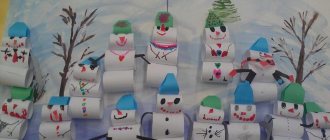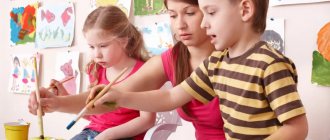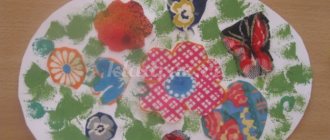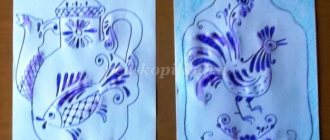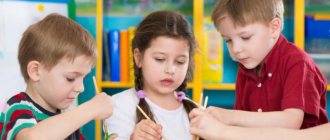Summary of the lesson “Time orientation” in the senior group of kindergarten
Lesson on FEMP at a preschool educational institution.
Senior group. Topic: Time orientation Program content : practice orientation on a sheet of paper; continue to teach asking questions using the words “how much”, “left”, “right”, “below”, “above”; practice counting within ten; in the name of the sequence of days of the week; develop attention and perseverance; fine motor skills of fingers; develop self-control skills. Demonstration material : cards for the game “Tangram”;
handouts: illustrations from the “Smart Book”; numbers up to seven; X. Cuisenaire's rods. Course of the lesson
1. Game “What is where?” You can use story pictures or toys. Children name where things are:
• A squirrel is sitting on a branch.
• Bunny under a bush. • Car behind the house. • Doll on the sofa. • Cube under the table. Etc. The teacher invites the children to ask each other what is on the right (left, above, below).
- Who is to the right of the tree?
- What's below? -What's up above the house? Etc. 2. Gymnastics for the eyes. Close eyes. Rest 10-15 s. Open eyes. Movements of the eyeballs: • eyes to the right - up; • eyes to the left - up; • eyes to the right - down; • eyes to the left - down. Close your eyes. Rest 10-15 s. 3. Game “Week, line up.” On the table there are upside-down cards with circles (or numbers) lying in disarray. Children, at a signal, take cards from the table and line up in order. Tasks: • children come out with cards with numbers indicating the days of the week after Thursday (children come out with the numbers five, six, seven); • a child comes out with a “Monday” card; • a child comes out with a card with the name of the day after Tuesday, and so on. 4. Game “Who knows, let him continue to count.” The teacher offers to count flowers (for example: tulips, dandelions, etc.). The teacher and children stand in a circle. The teacher says: “One dandelion” and throws the ball to the child, who catches the ball and continues: “Two dandelions,” throwing the ball to another child. And so on. Physical education lesson We will go right first - One, two, three. Now let's go left - One, two, three. And now we will all sit down - One, two, three. Let's stand up together and quietly - One, two, three. And now we will all dance - One, two, three. 5. Composition of numbers 6 and 7. Work with X. Cuisenaire sticks. The teacher reads a poem:
Number 1 - the very first snowball, 2 - a flower gently hung its head, 3 - the wind plays with the waves of the sea, 4 - the flag turns red (what color is it?), 5 - the color of the sun and dandelion, 6 - the colors of violets are more beautiful no, 7 - the soot in the chimney is getting blacker, 8 - ripe cherries have become tastier, 9 - fragile and pleasant like a bell, 10 - fresh and fragrant as an orange.
G. Popova Assignment: place a stick on the table that corresponds to the number 6 (purple). Children lay out the number six from other sticks (six white or yellow and white; two blue; three pink and so on). 6. Playing with sticks. On Monday - tangerine, And on Tuesday - orange, On Wednesday - chocolate, On Thursday - marmalade, On Friday - grapes, On Saturday - cookies, On Sunday - jam. I did the laundry on Monday, Paul swept on Tuesday. On Wednesday I baked a loaf of bread, I spent all Thursday looking for a ball, I washed the cups on Friday, and on Saturday I bought a cake. I invited all my girlfriends to my birthday party on Sunday. 7. Game "Tangram". Sample on the board:
Children assemble the square themselves. The one who collected it can compose the image according to his own design.
We recommend watching:
Summary of a lesson on FEMP in the senior group of kindergarten with a presentation. Composition of number 5 GCD for speech development in the senior group. A story on the topic “My favorite toy” Lesson notes for the senior group. Properties of paper Summary of GCD in the senior group on the topic: “Dandelion”
Similar articles:
Summary of a lesson in the senior group on the topic “Our Motherland – Russia”
Summary of a lesson in the senior group on the topic “Dishes”. Getting to know your surroundings
TIME ORIENTATION FOR PRESCHOOL CHILDREN
TIME ORIENTATION FOR PRESCHOOL CHILDREN
Content
1. Psychological foundations of time perception by preschool children
2. Contents of work on the development of time concepts in children in preschool educational institutions
3. Methodology of work on the formation of temporary representations in children in classes on mathematical development
Bibliography
1. Psychological foundations of time perception by preschool children
A person faces the problem of time every day, tearing off a piece of the calendar, every minute, looking at his watch. A child also lives in time, so the education and training program in kindergarten provides for the development of time orientation in children. The introduction of this section is due to a number of reasons. Children are introduced to the world around them, in which all events take place in time. The temporal characteristics of real phenomena, their duration, the order in which they follow each other, the speed of occurrence, the frequency of repetitions and rhythm must be shown and explained to preschoolers.
Already at preschool age, it is vitally important for children to learn how to navigate time themselves: to determine, measure time (correctly denoting it in speech), feel its duration (in order to regulate and plan activities in time), change the pace and rhythm of their actions depending on the availability of time. The ability to regulate and plan activities over time creates the basis for the development of such personality qualities as organization, composure, focus, precision, which are necessary for a child when studying at school and in everyday life.
At the same time, the specific features of time as an objective reality make it difficult for children to perceive it. Time is always in motion, the flow of time always occurs in one direction - from the past to the future, it is irreversible, it cannot be delayed, returned and “showed”. Therefore, even older preschoolers sometimes doubt the existence of time and ask: “If there is time, show it to me.”
How can a child show the time?
Time is perceived by the child indirectly, through the concretization of temporary units and relationships in constantly recurring phenomena of life and activity. Children's ideas about such periods of time, the skill of distinguishing which is formed on the basis of personal experience, are more accurate. Therefore, children need to be introduced to such time intervals that can be used to measure and determine the duration, sequence, and rhythm of their actions and various types of activities.
All measures of time (minute, hour, day, week, month, year) represent a certain system of time standards, where each measure is added up from the units of the previous one and serves as the basis for constructing the next one. Therefore, children’s acquaintance with units of time measurement should be carried out in a strict system and sequence, where knowledge of some time intervals, the ability to define and measure them, would serve as the basis for familiarization with the following and reveal to children the essential characteristics of time: its fluidity, continuity, irreversibility. In the process of various types of activities, children are exposed to a very complex set of stimuli, in which temporary relationships are only a weak and incidental component. According to the teachings of I.P. Pavlova, although a weak stimulus participates in the formation of temporary connections in a hidden form, taken separately, it does not cause a subsequent reaction. Therefore, time and the alternation of its specific segments must be made the subject of special attention for children, for which it is necessary to organize appropriate activities aimed at measuring time using instruments that demonstrate certain periods of time and their interrelationships. Such activities create the most favorable conditions for the formation of clear ideas about time.
Starting from the younger group, children developed time orientation. In the preparatory group for school, knowledge about such periods of time as morning, day, evening, night, week is consolidated, they are given an idea of the months, the children remember their names. Knowledge of time standards and the ability to establish temporary relationships contribute to children’s awareness of the sequence of events and the cause-and-effect relationships between them. Orientation in time should be based on a solid sensory basis, i.e., the experience of the duration of time in connection with the implementation of various activities, differently emotionally colored, as well as observations of natural phenomena and events of social life.Of great importance is how often children use the names of periods of time and measures of time in their speech. They continue to consolidate knowledge about the parts of the day and their duration. At the beginning of the school year, it is necessary to clarify what, when and in what sequence children and the adults around them do during the day. The teacher suggests playing the game “Our Day”!
When introducing children to the work of people in different professions, it is useful to show what time of day they work. To do this, you can use direct observations of children.
reading books, as well as didactic games “Who works during the day?”, “Journey in the evening”, “Journey at night”. While playing these games, children select pictures of appropriate content or name those who work at certain times of the day: morning, afternoon, evening, night.
Children are also reinforced with the idea that the day, which people usually call the word day, is replaced by one another and has its own names; 7 days make up a week. The sequence of days of each week is always the same: Monday, Tuesday, etc. Every morning, children name the current day, as well as the previous and subsequent ones.
It is important to encourage children as often as possible to establish temporary relationships, to use the words tomorrow, today, yesterday, first, then, before, after, before, before this, after that.
When composing stories from experience and retelling, the teacher monitors the exact transmission of the sequence of events and explains the meaning of time relationships. This is essential for understanding both the logic of temporal relationships and the events themselves that children observe or talk about.
The use of verbal game exercises “Days of the week”, “Continue!”, “On the contrary” is even more important. Children complete the phrase started by the teacher, select words of opposite meaning (morning - evening, first - then, quickly - slowly, etc.), determine what is longer: a day or a week, a week or a month, a month or a year.
Children in the preparatory group are introduced to the name of the current month. They gradually remember the names of the months and their order. Reading the book “Twelve Months” by S. Ya. Marshak contributes to quick memorization. It is important to instill in children a sense of time, that is, to develop a perception of the duration of time periods and an understanding of the irreversibility of time. Only on this basis is it possible to teach children to value and save time: to regulate their activities over time, that is, to speed up and slow down the pace of work, to finish work or play on time. In this regard, children need to accumulate experience in perceiving the duration of time periods. The teacher should help them imagine what exactly can be done in a given time period, and, finally, teach them to do everything on time.
The teacher constantly focuses the children’s attention on how much time they are given for this or that task, for example, how much time they can get dressed or undressed, draw, play, how many minutes are left until the end of the lesson, etc. Each time they indicate when the time is up, reward those who finish work on time
A developed sense of time helps children become more organized and disciplined.
The teacher invites one of the children to place the circles in 2 rows so that under each large one there is a small one, and says! “Is the circle left without a pair? What can we say about the number of circles! If you add 1 large circle, how many will there be? (Adds 1 large circle.) How many large circles are there now? How did we get 6 circles? Which circles are more (less): large or small? How many are there? Which number is greater (smaller): 5 or 6? How can we make sure that there are again as many large circles as small ones? (One of the children removes 1 large circle.) How many large circles are left? How did we get 5 circles? Are there equal numbers of large and small circles? How many are there?”
The teacher adds a large circle and says: “I add 1 to 5 large circles. How many are there? What needs to be done to have the same number of small circles? (The child adds 1 small circle.) How many small circles are there? How we got 6 laps! Are there equal numbers of circles now? How many are there?”
The method for obtaining the number 7 is considered similarly (illustrative material can be replaced).
Part 2 (work with handouts). “Count out the same number of toys as the number of blows you hear, and place them on the top (bottom) strip. (The teacher knocks 5 and 6 times.) Which strip has more (fewer) toys and why? How to make the number of toys equal – 6 each? Add 1 toy to the top strip. How many toys are there on the top and bottom stripes? Listen carefully! how many times the hammer hits, and place the same number of toys in the bottom strip. (“7.”) How many toys did you put on the bottom strip and why? Which strip has more toys? Why? How to make it so that there are equal numbers of toys on the top and bottom stripes! Equalize the number of toys."
Part 3 (working with the number ladder). “What is the smallest (largest) number of squares on our ladder? How many squares must be placed in the sixth column so that there is 1 square more there than in the fifth? (The child places squares in the sixth column.) If in the seventh column you place the same number of squares as there are in the sixth, and 1 more, then how many of them will there be and why? (One of the children places 7 squares.) What is the largest number on our ladder now?”
Part 4. Option 1. The teacher addresses the children: “Now we will learn to compare objects by size, find how they are similar and how they differ. Compare scarves: they are the same! are they the same length? in width? Which one is wider? already? How to check if you answered correctly? Who wants to do this? (One of the children, using the application technique, proves the correctness of the answer.)
Option 2. The teacher gives the child an object and asks: “Find an object longer (shorter, wider, narrower, etc.) than this one.”
Option 3. “Find objects on the table about which one can say that one of them is longer (shorter, wider, narrower, higher, lower, etc.) than the other.”
Note. These exercises can be used in subsequent classes.


